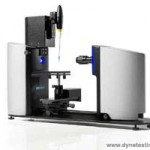 The York Plasma Institute (YPI), based at the University of York has recently purchased the Theta Optical Tensiometer for measuring contact angle on thin film plastic as part of their low temperature plasma research.
The York Plasma Institute (YPI), based at the University of York has recently purchased the Theta Optical Tensiometer for measuring contact angle on thin film plastic as part of their low temperature plasma research.
The York Plasma Institute (YPI) has a vision to establish a world-leading interdisciplinary plasma institute for the UK, with an international reputation for fundamental plasma science and related technology, collaborating with industries and universities, and fostering new start-up companies.
Optical Tensiometer can be used for highly accurate and easy measurements of:
• Wettability
• Surface tension
• Interfacial tension
• Contact angles
• Absorption
• Surface free energy
• Adsorption
• Spreading
• Cleanliness
• Surface heterogeneity
• Interfacial rheology
Dyne Testing offers a range of bench top and portable Optical Tensiometers for surface energy testing of plastics, metals, glass and many other materials. Rugged and simple-to-use Optical Tensiometers are a highly repeatable QC and analytical tool for measuring the contact angle on a variety of substrates.
The control of surface properties e.g. adhesion and wettability are of critical importance throughout the surface finishing industry. The adhesion and wettability properties of many materials are often poor leading to weak bonds between the coating, paint or adhesive applied and the substrate. To overcome this, the substrates’ surface needs to be treated to improve adhesion.
Contact angle measurement of the material surface can be used to measure the quality of a range of surface treatments e.g. Plasma, Corona and Flame treatments. Most of these surface treatments modify the surface energy and chemical properties of the surface of the materials by creating polar molecule groups on the surface thus increasing the surface energy. Measuring “contact angles” can be used to verify the cleanliness of a surface as well as its surface energy or polarity.
What is Contact Angle?
The contact angle,θ, is the angle at which the liquid/air interface meets up with the surface of the solid and is a quantitative measure of the wetting of a solid by a liquid. When a liquid droplet is deposited onto a smooth homogeneous and horizontal surface, it may spread out over the surface if wetting is complete, the contact angle will therefore approach zero. However, if surface wetting is partial, the resulting contact angle will reach equilibrium in the range of the material’s surface energy. The smaller the contact angle the greater the wettability or surface energy of the substrate is said to be. Contact angle is a good measure of surface wetting.
Contact Angle Measurement is the preferred and most accurate method of much vital production, laboratory and research measurement for determining the interactions at the solid/gas/liquid interface. The Optical Tensiometer or Contact Angle Meter is an ideal industrial or academic tool for product development engineers, R & D engineers who need precision and repeatability. Contact Angle Measurement combines high technology test instrumentation and a non-destructive testing method to allow an accurate, objective and repeatable surface analysis to be made. Using the contact angle meter you can compare the effects of a range of surface treatments and gather data that correlates to various surface conditions e.g. lubricity, wettability, surface energy etc.
You can learn more about contact angle measurement by clicking here. For further information on the work done at the York Plasma Institute visit http://www.york.ac.uk/physics/ypi/.












